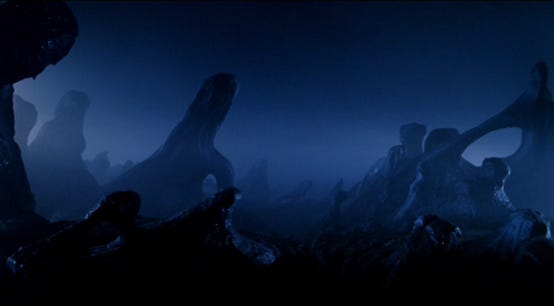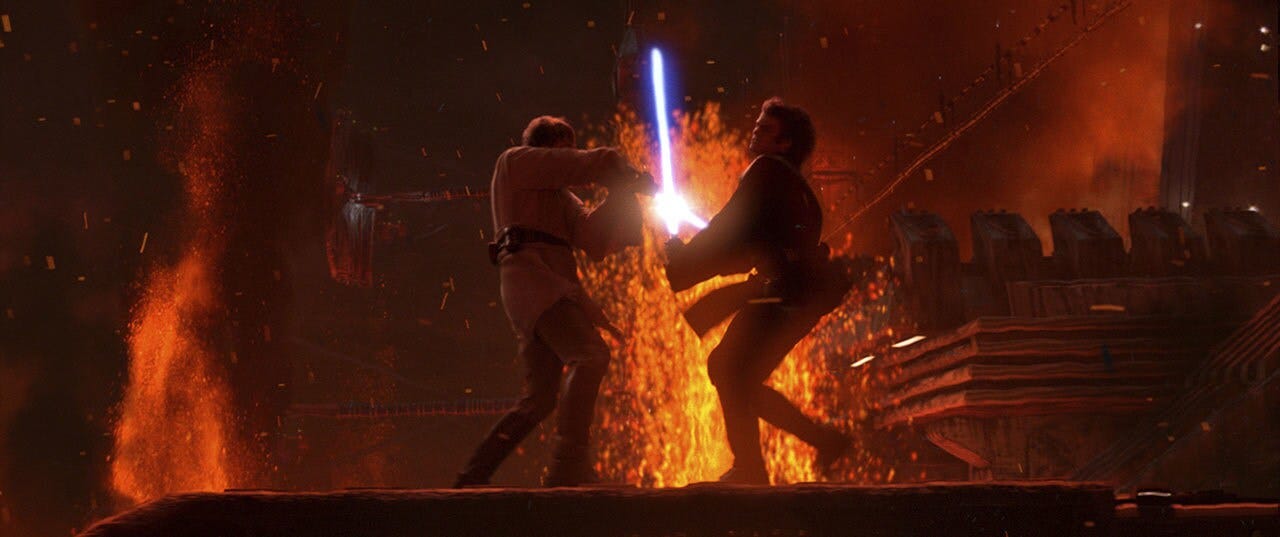Landscapes of doom: from Mordor to Mustafar
In our commentary on The Calibray Job's third episode 'Something In Between', we look at how places can feel and change alongside characters
The Calibray Job is a sci-fi/horror novella I’m serialising here on Altered Narrative. This is the behind-the-scenes commentary for the third episode. Read The Calibray Job, Episode Three: ‘Something In Between’ here.
“Upon its outward marges under the westward mountains Mordor was a dying land, but it was not yet dead. And here things still grew, harsh, twisted, bitter, struggling for life.” This is a passage from The Return of the King by J. R. R. Tolkien describing the desolate landscape of Mordor. He paints a picture of a painful place. A place of decay, where ‘twisted’ things are ‘struggling for life’.
Mordor is perhaps one of the most well-known examples of what I’m calling a ‘landscape of doom’. These are places where suffering is wrought on the land and not just the people. Where nature is suffering, dying or dead. Where the landscape ‘feels’ just as the characters do.
Not all landscapes of doom depict pits of lava and volcanoes spewing ash into a blackened sky. LV-426, the planet where the Nostromo picks up its extraterrestrial hitchhiker in Ridley Scott’s Alien, is a different kind of landscape of doom. It’s a grey world, a cold world. Where Tolkien uses fire, evoking imagery reminiscent of the Christian depiction of Hell in texts like Dante’s Inferno, Scott, and his production designer Michael Seymour, took a different approach. LV-426 recalls the stormy, alien landscapes of our solar system where temperatures are so frigid as to render their surfaces barren and lifeless. These are places of extremes. Extreme heat and extreme cold.
And then there are the more subtle landscapes of doom. As I mentioned in my piece about folk horror, the land itself is often depicted as the main antagonist. The 2008 film The Ruins, about a group of friends who fall victim to a mysterious ecological terror, is a great example of this idea. There the landscape rejects the human invaders, violently merging the human body with the natural landscape through some gnarly body horror. The land as antagonist is certainly the case with Mordor. Frodo and Sam’s journey is as much hindered by the landscape as it is the beasts that dwell in its cliffs and canyons.
On the surface level, these are dangerous places. As we’ve touched on, Mordor is a flaming hellscape filled with Orcs, spiders and all manner of evils. LV-427 is, of course, a breeding ground for chest-bursting alien creatures with spicy blood. They’re literal landscapes of doom, in that just simply going there spells certain doom for the characters.
Then you have the metaphorical level. To pull a term from my English Lit days, pathetic fallacy is described as the attribution of human emotions to non-human things. In the case of landscapes of doom, the emotions are fear, dread, anxiety, grief, and pain amongst others. These landscapes reflect the emotional state of the characters, making physical what these characters are going through within the story.
A great example of this is Mustafar in Star Wars: Episode III - Revenge of the Sith. At the point Anakin arrives on the lava world, he is at the apex of his internal conflict. His soul is burning with rage and the landscape reflects that fury. The fact that Anakin goes on to make Mustafar his base, even going so far as to build a castle on its obsidian cliffs, shows how Anakin has continually failed to let go of that rage.
A deep dive into the lore of Mustafar in Star Wars canon shows that the planet was once a lush world. That was until powerful resident Lady Corvax attempted to use a sacred crystal known as the Bright Star to resurrect her husband who had died in battle, ultimately scorching the land. Lady Corvax turned Mustafar into a landscape of doom after failing to let go of her husband. Her grief consumed not only her own mind but the landscape as well, much the same as Anakin’s rage.
Tolkien and the Environment
In all of this discussion about landscapes of doom, it’s impossible to ignore the obvious environmental parallels. Many of these landscapes, like Mustafar, are damaged thanks to human action. Emotions like anger and fear laid waste to these fictional worlds much the same way that greed is slowly laying waste to our own.
Much has been written about Tolkien’s legendarium and its relationship to the environment. It’s hard to not see shades of post-war industrial Britain in the imagery of Mordor. Similarly, the nighttime view of the Port Talbot steelworks in South Wales is eerily reminiscent of the neon-infused cityscape from Ridley Scott’s Blade Runner. These are real landscapes of doom.
All of this brings me to Calibray. In episode three, we finally arrive on the mysterious planet. My intention with this chapter was to evoke ideas similar to those I’ve discussed here. The planet is twisted, chaotic and unpredictable, reflecting the emotional state of the Sol’s crew at this point in their story.
“Sama set the Sol down in the thick of some trees set back from the lake. The bare branches were dense and thin strands of dark red wood, warped in pained expressions. As the Sol’s engines faded and her landing gear settled into the soft red clay, the silence of the forest seemed to entomb them. A noisy silence filled with a ceaseless ringing and faint, distant waves thrashing at the shore.” - The Calibray Job, Episode Three
I used the colour red as a motif to suggest that the world is bleeding. Nothing is as it seems on Calibray, everything is obfuscated both literally and figuratively. The reason behind the desolation of this world - and others in The System - will become clear the deeper into the story we go. What is already evident, I hope, is that Calibray is very much a landscape of doom.








![The Calibray Job, Episode Three [Novella]](https://substackcdn.com/image/fetch/$s_!FZXP!,w_140,h_140,c_fill,f_auto,q_auto:good,fl_progressive:steep,g_auto/https%3A%2F%2Fsubstack-post-media.s3.amazonaws.com%2Fpublic%2Fimages%2Fa868c09a-bb2e-4b65-9b27-fa3abcf69313_6912x3456.png)

